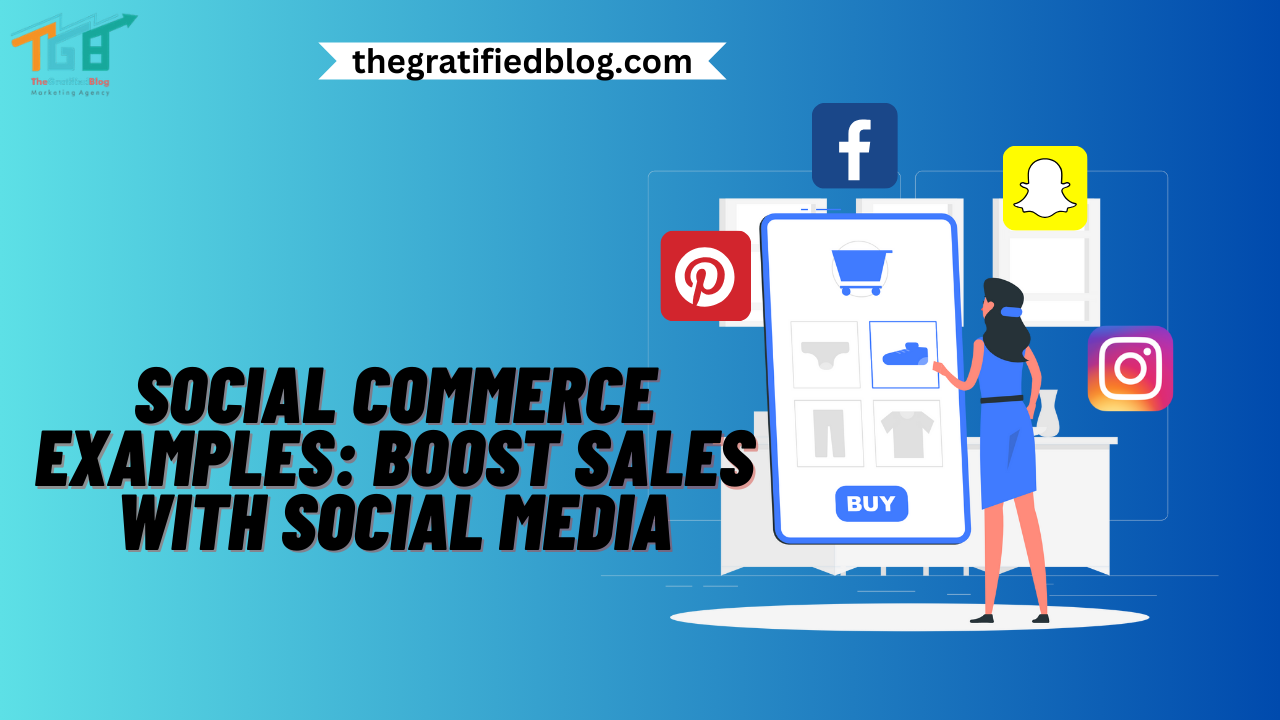
In the modern digital age, social media has surpassed its role as a platform for sharing photos and updates with friends. It has transformed into a formidable asset for businesses to leverage, boost sales, and engage with customers, thanks to a phenomenon known as social commerce.
In this article, we’ll explore social commerce, its benefits, critical elements of success, and popular social commerce platforms. We will also provide real-world examples of how businesses have leveraged it to their advantage.
What Is Social Commerce?

Social commerce represents a vibrant blend of social media and e-commerce, revolutionizing how businesses engage with customers online.
It involves leveraging social platforms to facilitate buying and selling products or services, making it easier for consumers to discover products, discuss them with peers, and make purchases seamlessly within their preferred social media environments.
Social commerce platforms often feature interactive features like live shopping streams, shoppable posts, and influencer collaborations, enhancing user engagement. This approach capitalizes on the power of social networks to drive sales and foster brand loyalty, bridging the gap between socializing and shopping.
Some tremendous social commerce examples include brands like Instagram’s “Shop Now” feature and Facebook Marketplace, seamlessly integrates shopping into the social media experience.
Social commerce has emerged as a game-changer for businesses seeking to connect with digitally savvy consumers and capitalize on social media platforms’ vast reach and influence. As the digital environment undergoes ongoing changes, social commerce is poised to play a central role in reshaping the future of online retail.
Social Commerce Platforms
Instagram Shopping

Through Instagram Shopping, businesses can label their products in posts and stories, enabling users to click and directly access the product page for seamless in-app purchases.
Facebook Marketplace

Facebook Marketplace provides a platform for users to buy and sell products locally. It also features e-commerce capabilities, making it a versatile choice for businesses.
Pinterest Shopping

Pinterest Shopping features shoppable pins that allow users to discover and buy products directly from pins, boards, and search results.
TikTok Shopping

TikTok Shopping offers in-app shopping experiences, enabling businesses to showcase and link products to their online stores.
Snapchat Shopping

Snapchat’s Try-On feature allows users to virtually try on products like clothing and cosmetics using augmented reality (AR) technology before purchasing.
Also read: A Complete Guide To Social Commerce Platforms In Detail
Social Commerce Examples

Social commerce involves purchasing and selling products or services directly through social media platforms. It combines the elements of e-commerce with social networking, making it easier for consumers to discover and purchase products while interacting with their social networks.
Here are some examples of social commerce:
Glossier’s Instagram Shopping
Glossier, a renowned skincare and cosmetics brand, ingeniously harnesses the power of Instagram Shopping to enhance the shopping experience for its customers. Through this innovative approach, Glossier strategically tags its products within visually captivating posts on its Instagram profile.
This clever integration allows consumers to explore and purchase cherished beauty items as they casually scroll through their Instagram feeds.
Glossier’s Instagram Shopping simplifies the shopping process and transforms its Instagram page into a virtual storefront, blurring the line between social media and e-commerce.
This strategy capitalizes on the platform’s visual appeal and ease of use, making it a prime example of social commerce in action, where the boundaries between inspiration and purchase are delightfully blurred for the modern consumer.
Airbnb Experiences On Facebook Marketplace
Airbnb has found a compelling way to harness the power of social commerce through its partnership with Facebook Marketplace. By integrating Airbnb Experiences into the Facebook Marketplace ecosystem, users can easily access a world of unique travel experiences.
This collaboration streamlines the travel planning process, offering travelers a convenient and seamless booking experience without leaving the Facebook platform.
Travel enthusiasts can now explore and reserve Airbnb Experiences directly within the familiar Facebook interface.
This strategic integration not only broadens Airbnb’s reach but also taps into the vast user base of Facebook, making it effortless for individuals to discover and book enriching adventures.
In a world where convenience is paramount, this example of social commerce demonstrates how two giants in their respective industries can create synergies that benefit travelers and businesses alike.
Sephora’s Pinterest Shopping
Sephora, a leading beauty retailer, employs Pinterest Shopping to create an engaging social commerce experience. Sephora effectively showcases its vast beauty products through this platform using shoppable pins.
Users browsing for beauty inspiration can seamlessly transition to purchasing directly within Pinterest. This integration allows customers to discover and buy products seamlessly and visually appealingly, bridging the gap between inspiration and action.
Sephora leverages the power of visuals and convenience, turning Pinterest into a virtual storefront that caters to the beauty needs of its audience.
It’s a prime example of how social commerce enhances user experience and drives sales through a visually immersive approach. Sephora’s Pinterest Shopping is a testament to the evolving online shopping landscape.
Shopify’s TikTok Integration
Shopify’s innovative TikTok integration has transformed the world of social commerce. This integration allows businesses to craft captivating, shoppable ads that resonate with a younger and highly engaged audience.
This strategic partnership empowers brands to showcase their products directly within the TikTok app, unlocking a vast marketplace for their offerings. Sellers can harness the viral nature of TikTok to boost visibility and drive sales, capitalizing on the platform’s immense popularity.
With easy-to-use tools and robust analytics, Shopify provides a dynamic platform for businesses to maximize their reach and conversions. This collaboration exemplifies the future of e-commerce, where social media and online shopping seamlessly converge, offering companies an exciting and lucrative avenue to thrive.
Levi’s Snapchat Try-On
Levi’s has embraced social commerce with its innovative Snapchat Try-On feature, revolutionizing how users shop for jeans. Through augmented reality (AR) technology, Levi’s allows customers to try their favorite denim styles within the Snapchat app.
This engaging experience not only injects an element of enjoyment into the shopping process but also addresses a common concern among online shoppers – the fit of the product.
By leveraging Snapchat’s platform, Levi’s reduces the uncertainty surrounding size and fit, boosting consumer confidence in their purchase decisions. The smooth integration of social media and e-commerce makes shopping for jeans more engaging and convenient.
Users can now visualize themselves in various Levi’s jeans before making a purchase, eliminating the guesswork and minimizing returns. Levi’s Snapchat Try-On is a prime example of how brands use social media to enhance the shopping journey and stay ahead in the ever-evolving world of e-commerce.
Tips For Implementing Social Commerce

Create Compelling Visuals
To successfully implement social commerce, creating compelling visuals is paramount. Invest in visually appealing content that captivates your audience and effectively showcases your products’ unique features and benefits.
High-quality images and videos can make your offerings stand out on social media platforms, enticing potential customers to explore further.
Ensure your visuals align with your brand’s identity and messaging, maintaining a consistent and recognizable aesthetic.
Utilize storytelling through visuals to create a connection with your audience, explaining how your products solve their problems or enhance their lives. Incorporate user-generated content, testimonials, and reviews to build trust and credibility.
Optimize your visuals for mobile devices to cater to the mobile-savvy consumer base on social platforms. Leverage features like shoppable posts and tags to facilitate seamless purchasing directly from your visual content.
You can boost engagement, drive conversions, and maximize your social commerce success by prioritizing compelling visuals.
Leverage User-Generated Content
To excel in implementing social commerce, harness the power of User-Generated Content (UGC). Encourage your customers to actively share their experiences and provide candid reviews of your products or services across social media platforms and your website.
By doing so, you not only foster a sense of community but also build trust and credibility among prospective buyers.
Simplify the process for customers to submit user-generated content (UGC) by creating user-friendly submission processes and incentivizing their contributions. Showcase this content prominently on your social commerce platform, as it serves as authentic testimonials that can influence purchase decisions.
Engage with users who share UGC, expressing gratitude and amplifying their content. Encourage conversations around these posts and create a dialogue with your audience.
This interactive approach boosts engagement and humanizes your brand, making it more relatable and trustworthy in the eyes of potential customers.
Optimize For Mobile Shopping
Prioritizing mobile optimization is paramount to implement social commerce effectively. Given that a significant majority of users shop via their smartphones, ensuring that your social commerce strategy is mobile-friendly is imperative.
Create a responsive website or app that Effortlessly Adapts to diverse screen sizes and devices, providing a user-friendly experience.
Consider streamlining the checkout process to be quick and hassle-free on mobile devices, reducing friction for potential customers. Implement touch-friendly navigation and intuitive design to enhance mobile user engagement.
Utilize mobile-specific functionalities such as push notifications and location-based features to personalize the shopping experience further.
Regularly test and optimize your mobile platform for performance and speed to minimize load times and enhance user satisfaction. A mobile-optimized approach will attract more users and boost conversion rates in social commerce.
Use Influencer Marketing
To successfully implement social commerce, consider leveraging influencer marketing as a powerful strategy. Partner with influencers whose values and interests align with your brand, as this will help you tap into their engaged and dedicated following.
Partnering with these influencers can extend your reach to a broader audience and gain credibility within their trusted circles.
Ensure that the influencers you select connect with your product or service to maintain authenticity. Create compelling and interactive content that highlights your offerings through their unique perspectives.
Utilize various social media platforms where these influencers have a solid presence to maximize your exposure.
To measure their effectiveness, define precise goals and key performance indicators (KPIs) for your influencer campaigns. Regularly monitor and analyze the results to refine your approach and enhance your social commerce efforts.
In doing so, you can harness the persuasive power of influencers to boost your brand’s presence and drive sales.
Monitor And Analyze Performance
To successfully implement social commerce, it’s crucial to prioritize monitoring and analyzing performance. Begin by setting up robust tracking mechanisms that capture relevant metrics, such as conversion rates, click-through rates, and engagement levels across your social platforms.
Consistently analyze this data to understand what’s working and what needs refinement. Identify trends, peak engagement times, and popular products or content that resonate with your audience. Use analytics tools and platforms to simplify the process and track progress over time.
Adjust your strategies based on these insights. Explore diverse content formats, posting timetables, and promotional approach techniques to optimize your social commerce campaigns.
By staying data-driven, you can continuously improve your efforts, enhance user experiences, and drive higher conversion rates and revenue in social commerce.
Future Trends In Social Commerce

Augmented Reality (AR) Shopping
Augmented Reality (AR) Shopping is poised to be a defining trend in the future of social commerce. With the evolution of AR technology, customers can virtually try out products before purchasing.
This immersive experience will enhance consumer confidence and reduce the risk associated with online shopping. Brands will invest in AR-driven platforms, enabling users to envision how products seamlessly integrate into their daily lives, ultimately driving higher conversion rates.
Social media platforms will integrate AR shopping features, creating seamless shopping experiences within their ecosystems. Customizable avatars and filters will allow users to personalize their virtual try-ons, further blurring the lines between online and offline shopping.
AR technology will reshape how consumers interact with products, making shopping more interactive, engaging, and, ultimately, more satisfying.
Voice Commerce
Voice Commerce is poised to be a dominant trend in the future of social commerce. As smart devices become more prevalent in voice assistants, consumers will find purchasing using just their voices easier than ever.
This technology simplifies buying, eliminating the need to navigate websites or apps. Voice-activated shopping will provide a seamless and convenient shopping experience, making it a preferred choice for many consumers.
Retailers and businesses will need to optimize their platforms for voice search and provide personalized recommendations through voice assistants to stay competitive in this evolving landscape.
With advancements in voice recognition technology, we anticipate this trend to reshape how we shop and interact with brands in the digital sphere, fostering more intuitive and efficient shopping experiences.
Social Commerce Chatbots
Chatbot integration is a prominent future trend in the evolving social commerce landscape. These AI-driven assistants, seamlessly woven into social commerce platforms, will revolutionize customer support by offering instant responses and addressing inquiries.
It is set to play a crucial role in improving and enhancing the shopping experience by delivering personalized product recommendations tailored to individual preferences and browsing history.
This fusion of AI and social commerce is poised to revolutionize how consumers interact with brands and make informed purchase decisions, ultimately driving greater customer satisfaction and sales.
Social Commerce On Emerging Platforms
In the realm of social commerce, adapting to emerging platforms is crucial. As new social media platforms continue to surface, businesses must remain nimble in their strategies to connect with evolving audiences.
Staying ahead of the curve allows early engagement with potential customers in these new digital spaces. Staying attuned to emerging trends platforms ensures businesses can leverage their unique features for effective social commerce.
Flexibility and foresight are vital in navigating the ever-changing landscape of social commerce.
Conclusion
Social commerce is reshaping the e-commerce landscape, Offering businesses inventive methods to connect with customers and drive sales.
By embracing social media platforms and incorporating critical elements for success, businesses can tap into the benefits of social commerce and stay ahead in an ever-evolving digital marketplace.
As the industry undergoes ongoing changes, staying vigilant about emerging trends will be crucial for sustained success in social commerce.








No Comments